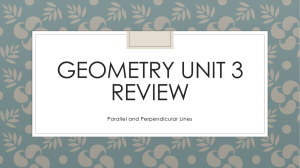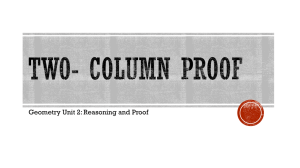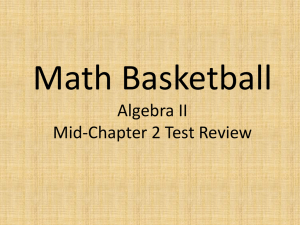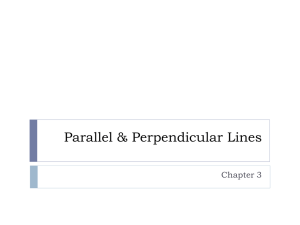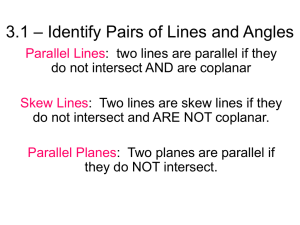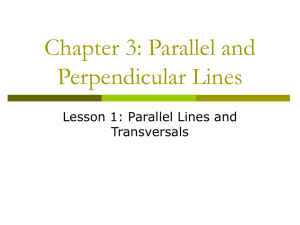Unit 4 Honors Geometry
advertisement
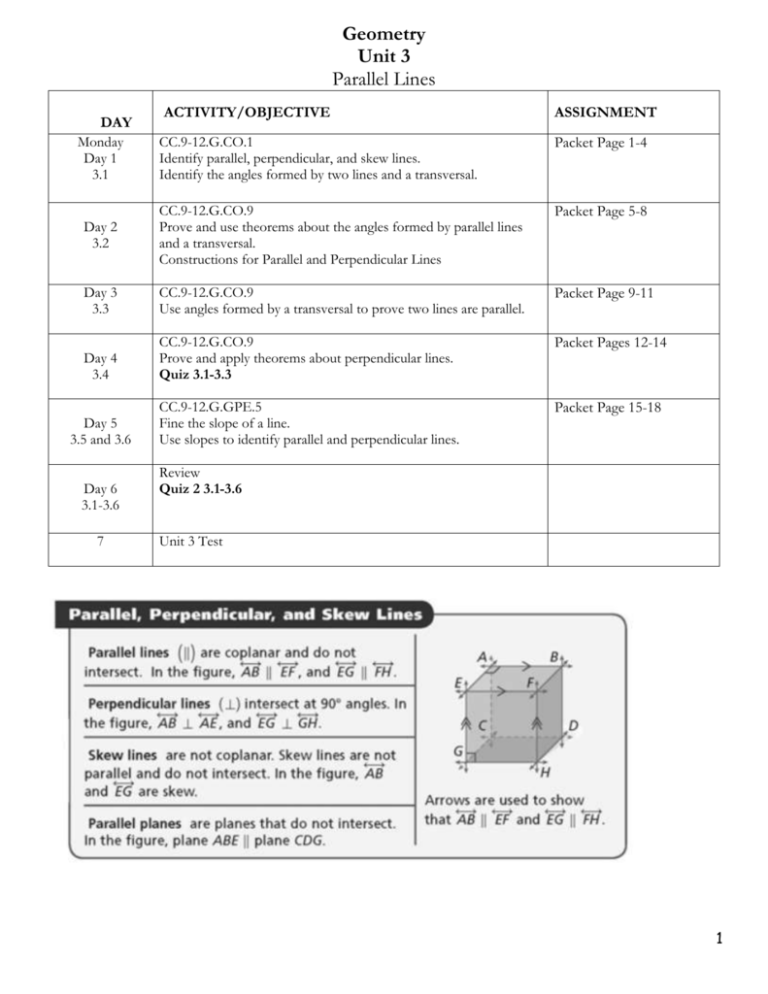
Geometry Unit 3 Parallel Lines DAY Monday Day 1 3.1 ACTIVITY/OBJECTIVE ASSIGNMENT CC.9-12.G.CO.1 Identify parallel, perpendicular, and skew lines. Identify the angles formed by two lines and a transversal. Packet Page 1-4 Day 2 3.2 CC.9-12.G.CO.9 Prove and use theorems about the angles formed by parallel lines and a transversal. Constructions for Parallel and Perpendicular Lines Packet Page 5-8 Day 3 3.3 CC.9-12.G.CO.9 Use angles formed by a transversal to prove two lines are parallel. Packet Page 9-11 Day 4 3.4 CC.9-12.G.CO.9 Prove and apply theorems about perpendicular lines. Quiz 3.1-3.3 Packet Pages 12-14 Day 5 3.5 and 3.6 CC.9-12.G.GPE.5 Fine the slope of a line. Use slopes to identify parallel and perpendicular lines. Packet Page 15-18 Day 6 3.1-3.6 7 Review Quiz 2 3.1-3.6 Unit 3 Test 1 Define Transversal: Name the obvious transversal(s): c 1. a a 2. b 3. a c b c b When 2 coplanar lines are cut by a transversal, 8 angles are formed: INTERIOR ’s: EXTERIOR ’s: Some of these angles have a relationship that we have previously studied. LINEAR PAIRS: VERTICAL ’s: c b 6 7 a 5 8 1 2 3 4 TYPES OF ANGLES Alternate Interior ’s: ______________ interior ’s on ______________ sides of the transversal. Name the Alt. Int. ’s: Same–Side Interior ’s (consecutive int. ’s): Two ____________ ’s on the same side of the transversal. Name the S.S.int. ’s: Corresponding ’s: Two angles in ______________ ______________ relative to the two lines. Name the Corr. ’s: Alternate Exterior ’s: ______________ exterior ’s on ______________ sides of the transversal. 2 Name the Alt. Ext. ’s: 2 Use the given line as a transversal: 1. Name alt. int ’s using line x: 1 3 4 y 2. Name s.s. int. ’s using line y: 3. Name corr. ’s using line z: 4. Name alt. ext. ’s using line y: 6 8 7 5 10 9 11 12 5. Name alt. int. ’s using line z: 6. Name s.s. int ’s using line z: z x Tell whether the statement is true or false. If false, sketch a counterexample. Do not assume points are coplanar unless specified. _______1. If a line intersects one of two parallel lines, then it must intersect the other. _______2. If two lines are coplanar, then they must be parallel. _______3. Two coplanar line segments, which have no point in common, must be parallel. _______4. Two lines, which are parallel to the same line, must be parallel to each other. _______5. If a plane contains one of two parallel lines, then it must contain the other. _______6. If a line is parallel to a plane, then it is parallel to every line in the plane. _______7. If two lines are to the same line, then they must be parallel to each other. _______8. If two planes are to the same line, then they must be parallel to each other. _______9. If two lines are skew to a third line, then they must be skew to each other. _______10. Two planes, which are parallel to the same plane, must be parallel to each other. 3 a y x 5 8 1 4 2 7 6 b 3 9 12 14 10 15 13 11 16 17 18 19 Assume a ⁄⁄ b. Complete the chart. ANGLES 1. 1 and 14 2. 2 and 15 3. 7 and 9 4. 9 and 16 5. 10 and 17 6. 16 and 14 7. 9 and 14 8. 18 and 19 9. 1 and 16 10. 3 and 8 11. 6 and 9 12. 12 and 13 13. 7 and 11 14. 6 and 8 15. 4 and 13 16. 9 and 12 TRANSVERSAL TYPE , SUPPL., OR NONE (relationship between angles) 4 Day 2 - If 2 lines are parallel and they are intersected by a transversal, then the following is true about each pair of angles: : Alternate Interior Angles: 3 6 4 5 Examples – Find the measures of the angles (or value of the variables(s)). 3. 2. 1. 6. 5. 9. 4. 7. 10. 8. 11. 5 6 The Converse of each theorem also works: Converse of the Alternate Interior Angles Theorem: Converse of the Alternate Exterior Angles Theorem: Converse of the Same-Side Interior Angles Theorem: Converse of Corresponding Angles Postulate: Is it possible to prove the lines are parallel or not parallel? If so, state the postulate or theorem you would use. If not, state cannot be determined. 1. 2. 3. 92° 88° l k 7 4. 5. 6. l k 7. A 105° E 8. B I C D 9. k 122° 75° H 55° l F 58° 55° m G Find the value of x so that n || m. State the theorem or postulate that justifies your solution. 5x 10. n 11. m 5x+23 n 7x+13 m 5x-18 12. n m 8x-5 3x+48 x= x= x= _____________________ _____________________ _____________________ Can you prove that lines p and q are parallel? If so, state the theorem or postulate that you would use. p 13. p q 14. p 15. q _____________________ Name the type for each pair of angles 16. 1 8 17. 4 6 18. 10 7 19. m3 + m4 = 180 20. 5 3 21. 6 7 q _____________________ _____________________ k j 3 1 4 5 2 10 l 6 8 9 7 n p 8 Day 3: Parallel Proofs t l 1 2 m 3 4 5 1. Given: l // m; 1 4 Prove: s // t 1. l // m ; 1 4 1. _______________________________________ 2. 3 1 2. _______________________________________ 3. 3 4 3. _______________________________________ 4. s // t 4. _______________________________________ 2. Given: l // m ; 2 5 Prove: s // t 1. l // m ; 2 5 1. ________________________________________ 2. 2 3 2. ________________________________________ 3. 3 5 3. ________________________________________ 4. s // t 4. ________________________________________ 3. Given: l // m; s // t Prove: 2 4 1. l // m ; s // t 1. ________________________________________ 2. 2 3 3 4 3. 2 4 2. ________________________________________ 3. ________________________________________ 4. Given: l // m; s // t Prove: 1 5 1. l // m; s // t 1. _________________________________________ 2. 1 3 3 5 3. 1 5 2. _________________________________________ 3. _________________________________________ 9 5. Given: 3 is supplementary to 5. Prove: BD // FE 1. 3 is supplementary to 5 1. _________________________________________ 2. m3 + m5 = 180 2. _________________________________________ 3. 3 4 3. _________________________________________ 4. m3 = m4 4. _________________________________________ 5. m4 + m5 = 180 5. _________________________________________ 6. 4 is supplementary to 5 6. _________________________________________ 7. 7. _________________________________________ BD // FE B A 6. Given: 2 5; BE bisects CBD. Prove: AC // DE 1 D 1. 2 5; BE bisects CBD. 2. 3. 3 5 3. 4. 4. AC // DE 8. Given: l // m ; s // t Prove: 1 5 9. Given: l // m; 1 4 Prove: s // t C 3 4 5 E 1. 2. 3 2 7. Given: l // m ; s // t Prove: 2 4 2 s Diagram for # 7 - 10 l t 1 2 m 3 5 4 10. Given: l // m; 2 5 Prove: s // t 10 11. Given: BC // EF ; BA // ED Prove: B E A D C P B E 12. Given: AB //DE Prove: mACD = mBAC + mCDE F A B C E D 13. Given: g // h; g // j Prove: 2 3 g 1 2 h 3 14. Given: AB //CD ; BC //DE Prove: B D j C A E B D 15. Given: a // c; 1 2 Prove: b // c 2 1 a 16. Given: C is a supplement of D Prove: A is a supplement of B b B A c C D 11 Day 4: Perpendicular Lines Perpendicular Bisector is a line perpendicular to a segment at the segment's midpoint. Distance from a point to a line the length of the perpendicular segment from the point to the line. 1- 6 Use the given diagram on the right, in which AM = MB. C 1. Name a pair of rays. 2. ____ is the bisector of ____. 3. Name a linear pair of angles which are . 4. If t in X is to 5. If A M B AB at M, what can you say about t and CM ? Why? MR in X is a bisector of AB , then R is on CM . Why? 6. If p contains M and is to the plane determined by CM and AB , then p ___ CM and p ___ AB . Why? 7. In a plane , how many lines can be to a given line at a given point? 8. Would your answer be different if the words “in a plane” were omitted from the question? Homework on Perpendicular Lines. True or False. If false, give a counterexample. _____1. If PQ PR , then QPR is a right angle. ______2. If AB CD , then ABC is a right angle. _____3. If 2 lines intersect to form a right angle, then the lines are . ______4. There is exactly one line to a given at a given point on the line. _____5. If 2 angles are a linear pair, then each is a right . ______6. A given segment has exactly one bisector. _____7. If M is the midpoint of AB and if AB is to plane X at M, there is exactly one line in X which ______8. If 2 adjacent angles are , then each is a right angle. is a bisector of AB . 12 In 9 – 13 refer to the diagram below and the given info. : mCAB = 90; CDA BDA; EA AB ; mECB = 90 C **Mark the diagram with the given information** X 9. What pairs of lines are ? D 10. ____ is a bisector of ____. Why? E A 11. If FC in X is a bisector of EB , then F is on AC . Why? 12. If t is a line in the plane of the diagram, and t BC at D, how are t and AD related? Why? 13. If G is on B CE and EGA CGA, how are AG and EC related? Why? 14. If l m and m n, is l n? Explain. 15. If m n, is n m ? Explain. 13 1.The perpendicular bisector of a segment is a line ______________________ to a segment at the segment’s ______________________. 2. The shortest segment from a point to a line is ______________________ to the line. For Exercises 3 and 4, name the shortest segment from the point to the line and write an inequality for x. 3. 4. ________________________________________ ________________________________________ Fill in the blanks to complete these theorems about parallel and perpendicular lines. 5. If two coplanar lines are perpendicular to the same line, then the two lines are ______________________ to each other. 6. If two intersecting lines form a linear pair of ______________________ angles, then the lines are perpendicular. 7. In a plane, if a transversal is perpendicular to one of two parallel lines, then it is ______________________ to the other line. Use the drawing of a basketball goal for Exercises 8–10. In each exercise, justify Esperanza’s conclusion with one of the completed theorems from Exercises 5–7. Write the number 5, 6, or 7 in each blank to tell which theorem you used. 8. Esperanza knows that the basketball pole intersects the court to form a linear pair of angles that are congruent. She concludes that the pole and the court are perpendicular. ______________________ 9. Esperanza knows that the hoop and the court are both perpendicular to the pole. She concludes that the hoop and the court are parallel to each other. ______________________ 10. Esperanza knows that the hoop and the court are parallel to each other. She also knows that the hoop is perpendicular to the pole. Esperanza concludes that the pole and the court are perpendicular. ______________________ 14 Day 5 Slopes of Lines 15 Graph each pair of lines. Use slopes to determine whether the lines are parallel, perpendicular, or neither. 2. IJ and KL for I(1, 0), J(5, 3), K(6, 1), and L(0, 2) _______________________ 3. PQ and RS for P(5, 1), Q(1, 1), R(2, 1), and S(3, 2) _______________________ whether each pair of lines is parallel, perpendicular, or neither. 4. EF with slope3 and GH with slope1 5. PQ with slope _____________________ 2 3 and RS with slope 3 2 _____________________ Match the letter of each example to the correct form of a line. 6. point-slope form _________ A. x3 7. slope-intercept form _________ B. yx1 8. horizontal line _________ C. y 7 9. vertical line _________ D. y 2 ( x 6) Write the equation of each line in the given form. 10. the horizontal line through (3, 7) in point-slope form ________________________________________ 1 7 12. the line through , and (2, 14) in 2 2 slope-intercept form 1 2 11. the line with slope 8 through (1, 5) in 5 point-slope form _________________________________________ 13. the line with x-intercept 2 and y-intercept 1 in slope-intercept form 16 Write the equation of each line in the given form. Graph each line. 14.the line with slope 2 and y-intercept 1 in slope-intercept form ________________________________________ 16. the line through (0, 0) and (2, 2) in slope-intercept form 15. the line with slope 2 through (4, 4) in 3 point-slope form _________________________________________ 17. the line through (1, 1) and (0, 2) in point-slope form Graph each line. 18. y 3 3 ( x 1) 4 19. y 4 x2 3 Determine whether the lines are parallel, intersect, or coincide. 20. x 5y 0, y 1 1 ( x 5) 5 1 x 1 y 2 3 1 22. y 4( x 3), 4y x 4 4 21. 2y 2 x, ____________________ ____________________ ____________________ 17 Write the equation of each line in the given form. 1. the horizontal line through (3, 7) in point-slope form 2. the line with slope 8 through (1, 5) in 5 point-slope form ________________________________________ 1 7 3. the line through , and (2, 14) in 2 2 slope-intercept form ________________________________________ _________________________________________ 4. the line with x-intercept 2 and y-intercept 1 in slope-intercept form _________________________________________ Graph each line. 5. y 3 3 ( x 1) 4 6. y 4 x2 3 Determine whether the lines are parallel, intersect, or coincide. 7. x 5y 0, y 1 1 ( x 5) 5 1 x 1 y 2 3 1 9. y 4( x 3), 4y x 4 4 8. 2y 2 x, ____________________ ____________________ ____________________ 18




